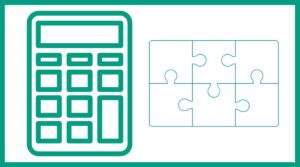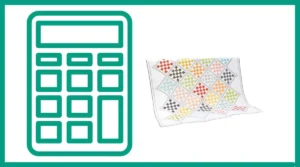The HST Quilt Calculator simplifies the process of creating half-square triangles for your quilting projects.
How the HST Quilt Calculator Works
The calculator operates on a simple principle: you input the desired finished size of your HST units, and it provides the dimensions for cutting fabric squares using three different HST construction methods. Here’s a breakdown of how to use the calculator:
- Enter the finished HST size in inches in the provided input field.
- Click the “Calculate” button.
- Review the results displayed in a clear, tabular format.
The calculator offers measurements for three popular HST construction techniques:
- 2-at-a-time method
- 4-at-a-time method
- 8-at-a-time method
Each method has its advantages, and the choice often depends on the number of HSTs needed for your project and your personal preference.
Exploring HST Construction Methods
2-at-a-Time Method
The 2-at-a-time method is the most straightforward approach to creating HSTs. For this technique, the calculator provides the size of two squares you need to cut. These squares will be placed right sides together, marked with a diagonal line, and sewn on both sides of the line. When cut apart on the marked line, you’ll have two identical HSTs.
Example:
If you enter a finished HST size of 3 inches, the calculator will suggest cutting two squares at 4 inches each for the 2-at-a-time method. This extra inch accounts for seam allowances and potential trimming to achieve precise final dimensions.
4-at-a-Time Method
The 4-at-a-time method is more efficient when you need multiple HSTs of the same color combination. This technique involves sewing around all four sides of two layered squares and then cutting them diagonally in both directions to yield four HSTs.
Example:
For a finished HST size of 3 inches, the calculator might recommend cutting two squares at approximately 4.74 inches each for the 4-at-a-time method. This measurement is derived from a formula that accounts for the diagonal cuts and seam allowances.
8-at-a-Time Method
The 8-at-a-time method is ideal for projects requiring numerous HSTs of the same color pairing. This technique involves creating a grid of seams on two large squares of fabric, then cutting them into smaller squares and diagonally to produce eight HSTs at once.
Example:
If you’re aiming for 3-inch finished HSTs, the calculator would suggest cutting two squares at 8 inches each for the 8-at-a-time method. This larger size accommodates the multiple cuts and seam allowances needed to produce eight units simultaneously.
Benefits of Using the HST Quilt Calculator
Accuracy in Fabric Cutting
One of the primary advantages of using the HST Quilt Calculator is the increased accuracy in cutting fabric pieces. By providing precise measurements for each method, the calculator helps eliminate common errors associated with manual calculations or guesswork. This accuracy is crucial for creating well-fitting HSTs that come together seamlessly in your quilt top.
Time-Saving Efficiency
Calculating the correct fabric sizes for HSTs can be time-consuming, especially when working with multiple sizes or methods. The HST Quilt Calculator streamlines this process, allowing you to obtain accurate measurements instantly. This efficiency enables quilters to spend more time on the creative aspects of their projects and less time on mathematical computations.
Reduced Fabric Waste
Incorrect calculations can lead to wasted fabric, which is both costly and frustrating. By providing exact measurements, the HST Quilt Calculator helps minimize fabric waste. This not only saves money but also aligns with sustainable quilting practices, allowing you to make the most of your fabric resources.
Flexibility in Project Planning
The calculator’s ability to provide measurements for three different HST construction methods offers quilters greater flexibility in planning their projects. You can easily compare the cutting requirements for each method and choose the one that best suits your project’s needs, whether you’re making a few HSTs or hundreds.
Tips for Using the HST Quilt Calculator Effectively
To get the most out of the HST Quilt Calculator, consider the following tips:
- Always double-check your input: Ensure you’ve entered the correct finished HST size to avoid calculation errors.
- Round up for added security: When cutting fabric, it’s often wise to round up to the nearest 1/8 inch to allow for slight variations in cutting and sewing.
- Test with scraps: Before cutting into your project fabric, use the calculator’s measurements to create test HSTs with scrap fabric. This allows you to verify the accuracy of the finished size and make any necessary adjustments.
- Consider your project needs: Evaluate which HST construction method is most suitable for your project based on the number of units needed and the variety of color combinations required.
- Account for fabric shrinkage: If you plan to pre-wash your fabric, you might want to add an extra 1/4 inch to the calculated measurements to compensate for potential shrinkage.
Incorporating HSTs in Your Quilt Designs
Half-square triangles are incredibly versatile and can be used to create a wide variety of quilt patterns. Here are some popular designs that heavily feature HSTs:
- Pinwheel blocks
- Flying geese
- Star blocks
- Chevron patterns
- Diamond layouts
Experimenting with different color combinations and arrangements of HSTs can lead to stunning and unique quilt designs. The HST Quilt Calculator facilitates this experimentation by making it easy to calculate sizes for various projects.
Troubleshooting Common HST Issues
Even with precise calculations, you might encounter some challenges when working with HSTs. Here are some common issues and solutions:
- Inaccurate finished size: If your HSTs are consistently too small or large, check your seam allowance and pressing technique. Adjust as needed or consider adding an extra 1/8 inch to your initial squares.
- Distorted shapes: To maintain the square shape of your HSTs, avoid stretching the fabric when pressing and handle bias edges carefully.
- Bulky seams: When multiple HSTs come together at a single point, seams can become bulky. Consider pressing seams open or using a pressing technique that distributes bulk more evenly.
- Uneven diagonal seams: Use a marking tool to draw accurate diagonal lines before sewing. A quarter-inch foot can also help maintain consistent seam allowances.





